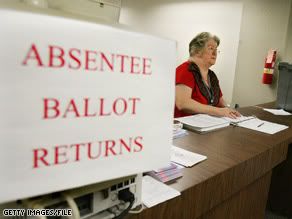This is part of a two-part series evaluating absentee ballots, which are being used more and more often. The first part will focus on their advantages. The second part will focus on their disadvantages.
Absentee ballots are increasingly being used throughout the United States. They are especially popular in the West Coast; elections are entirely absentee-ballot in Oregon and Washington, for instance.
More below.
The general reasoning behind absentee ballots are that they increase voter turn-out. The theory goes that voters too busy on election day can vote before the election. Absentee ballots make voting simpler, people say. If it is true that absentee ballots increase voter turn-out, then this would be a substantial advantage. At least one study, on the other hand, casts doubt on whether this is really true.
There is another great advantage to absentee ballots, however.
In the state of California, at least, voter ballots go on for pages and pages. Voters are asked to vote on a huge array of things which they almost certainly haven’t heard of. Everyone has heard of the presidential race. But very few people know about candidates for the local school board or local bond measures. What if one of the candidates is a convicted felon? What if that local ballot proposal is actually the pet project of a big corporation? Often a voter in the booth will only see four names he or she’s never seen before, or a paragraph-long description of a proposed measure. There’s no way for him or her to know how to vote.
Voters who receive absentee ballots don’t face this problem. They can research the candidates or the proposed local measure. They can look online to see whether the candidate for the local school board has an extremely controversial background. They can look at what the newspapers have to say about that local bond measure.
Absentee ballots enable voters to make informed decisions, especially about local elections and measures which nobody has heard of.
They certainly helped me when I voted. I remember voting for the board members on the local fire protection district. Unsurprisingly, I had no idea who any of the candidates were. The voter information pamphlet seemed to be helpful, and I settled on three candidates who seemed to have the best-written candidate statements.
Then I researched who these people actually were. It was fairly simple: I merely typed the candidates’ names and the word “controversy” in Google.
It turned out that all three candidates I’d picked were close relatives of firefighters! Since the fire protection board must bargain with firefighters about their pay, this was obviously a huge conflict of interest. I immediately changed who I was going to vote for. I’d never have known about this if I hadn’t had the time to research the candidates before filling out my absentee ballot.
This is why absentee ballots are great. But they also have some big disadvantages (actually one big disadvantage). That’s the subject of part two.
–inoljt
